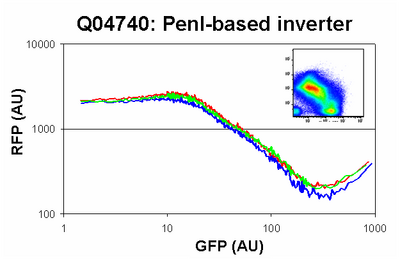IGEM:IMPERIAL/2007/Projects/Hrp System/Design
Hrp Characterisation: Design
Required to meet the characterisation specification.
Measuring PoPS
 |
As mentioned above there is no current method to directly measure PoPS and so we have to measure PoPS indirectly. An example of indirect measurements is measurement of protein molecules synthesised.
PoPS of promoter
We need to measure PoPS for the see specified parts and promoters. However, measuring PoPS is tricky. In order to measure PoPS for input promoters, it is proposed to attach a fluorescent protein to the same operon containing the promoter of interest and input coding sequences. An input GFP synthesis per CFU per second measurement can then be obtained. The image to the right shows how a plot showing the relationship between PoPS in and PoPS out can be constructed using this technique.
Note, however, that this value needs to be corrected for the expression difference arising from the distance between the coding sequence and the promoter. One method proposed is to perform the experiment with two plasmids, with the following sequences: Promoter-GFP-Protein and Promoter-Protein-GFP. This allows for the correction in PoPS in and PoPS out, and would give a more realistic measurement of PoPS for the system.
PoPS of Device
We need to measure the Output of PoPS from our device so that features like the transfer function can be characterised. Again to the measure the PoPS a fluorescent protein can be used. This fluorescent protein must be different to the one used to measure the input so that they can be separately measured, for example use of red fluorescent protein(RFP). The output can then be measured in terms of RFP synthesis per CFU per second.
Note: Standard RBS meeds to be cloned in
Pilot experiment done before full experiment